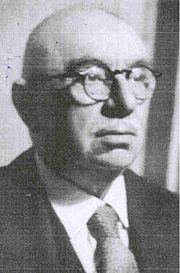Preceded by Ismail Qemali | Name Fejzi Alizoti Role Politician | |
 | ||
Profession Politician, economist, administrative clerk Died April 14, 1945, Tirana, Albania | ||
Succeeded by Turhan Pashe Permeti | ||
Fejzi Alizoti (22 September 1874, Gjirokastër – 14 April 1945, Tirana) also referred as Fejzi Bey Alizoti, was an Ottoman and later Albanian politician and as the 2nd Prime Minister of Albania from January to March 1914.
Life
Alizoti was born in Yanina Ioanina, back then Ottoman Empire in a powerful family. His grand-grandfather was Alizot Pasha who had ruled for a very short time (1787) the Vilayet of Yannina after the death of Ahmet Kurt Pasha. His father Hasan Bey Alizoti was a local bey. At the age of 8, Alizoti was sent to study in Yannina. After that he finished the Classic Gymnasium of Salonika in 1890 and return to Gjirokastër. After that he left for Istanbul, where he studied at Mekteb-i Mülkiye economics and civic administration. After the graduation he was sent in Syria where he worked as part of the Ottoman administration for 3 years. After succeeding the first assignment he was appointed Prefect of Homs in the Tripoli Eyalet, and later in the Bilecik province. In 1906 he wrote to the High Porte asking to be transferred somewhere in the Albanian areas. With the intervention of some friends of him in the capital, he was transferred as Prefect of Korçë. After the Young Turk Revolution and the new constitution he was sent Prefect in Prizren, Vilayet of Kosovo until March 1910 when the unrest in Albanian Vilayets would increase following with the Albanian rebellions. Alizoti was recalled to Istambul and sent to Romania for a specialization course. After 6 months he returned and started as Administrator of Urfa in Asia Minor, and after that as Governor of Al-Khums in Western Libya.
According to Elsie, the Italians arrested him during the Italo-Turkish War for Libya and interned in a camp in Italy. There he would become one of the greatest Italophiles in Albanian history staying a loyal supporter of Italian interests. According to Albanian sources, he was recalled from the Ottoman authorities and sent as Administrator in the Dodecanese islands. After that, with the start of the Albanian Revolt of 1912, the Ottoman authorities sent him together with Abdyl Ypi as a best-fit "mediator" to calm down the Albanian rebels of the Labëria region who had already gathered an Assembly in Cepo, near Gjirokastër, and aligned their demands with the rebels in the north. The attempts were unsuccessful even though Ypi and Alizoti managed to organize a meeting with rebel leaders in Tepelenë on August 18. Ismail Qemali wrote to Alizoti and asked to join him in Vlorë after the Declaration of Independence.
For a short time in 1914 Alizoti was the 2nd Prime Minister under the auspices of the International Commission of Control. Under Prince Wied he served as secretary-general of the Ministry of the Interior, and Prefect of Shkodra, investigating Albanian officers who were suspected to had taken part in the Islamic Revolt. He strongly opposed Essad Toptani and his parallel government in Durrës. During World War I he worked with Austrian occupation forces as Financial Director of the Civilian Administration Council set up by August Ritter von Kral (1869-1953).
Alizoti was Minister of Finances of Albania in 1918–1920. He was one of the prominent members of the Congress of Durrës. Later in 1920 he would take an opponent stance towards the Congress of Lushnjë, which replaced the pro-Italian government of Durrës with a new one, establishing the territorial sovereignty of Albania. According to Sejfi Vllamasi's (1883–1975) memories, Alizoti, together with Mustafa Merlika-Kruja, Myfit Libohova, and Sami Bey Vrioni would try to prohibit the delegates for joining the Lushnje event. Ahmet Zogu would call him a "traitor" for that. After the attempts failed, Alizoti escaped shortly to Corfu avoiding any reaction from the congress supporters.
During the June Revolution of 1924 he supported Ahmet Zogu, who needed him because of his good relations with the Italians. After Zogu's rise in power Alizoti took part in various negotiations between Albania and Italy, always siding with Italy to the detriment of Albanian interests, to the extent that he was called the "kavass of the Italians". From February to October 1927 he was Minister of Finance and shortly substituting his ally and friend Iliaz Vrioni. He played a major role in the proclamation of the Albanian Monarchy in 1928. Alizoti proposed that Zog was called not only "King of Albania" but "King of the Albanians" including so even the Albanian population outside the borders. During the Italian occupation he served again as Minister of Finances in Shefqet Vërlaci's government from April 12, 1939 to 1940.
Arrested on April 14, 1945 by the Stalinist Communists, Under direct orders from the communist regime's Special Court with completely unqualified judges and attorneys he was sentenced to death by a firing squad. The court was headed by Koci Xoxe who's real profession was a metal worker with only four years of schooling. The Genocide on the intellectual elite of the Albanian nation under the communist terror leaving behind his wife and five offsprings. His family would be persecuted. During all communist era, he would be recalled as "traitor, collaborationist, feudal, corrupt, and Italian agent". His son Riza Alizoti (1915-1947) was arrested and accused of being a spy and a saboteur of the petroleum fields of Kuçovë with a group of other engineers known as "Saboteurs group" (Albanian: Grupi i sabotatorëve). He was executed on 10 October 1947 by hanging.
A special reference would be made during the communist era to one Alizoti's famous sayings regarding higher education ("...there is intellectual overproduction in Albania"), considering that 80-85% of the Albanians were illiterate.
